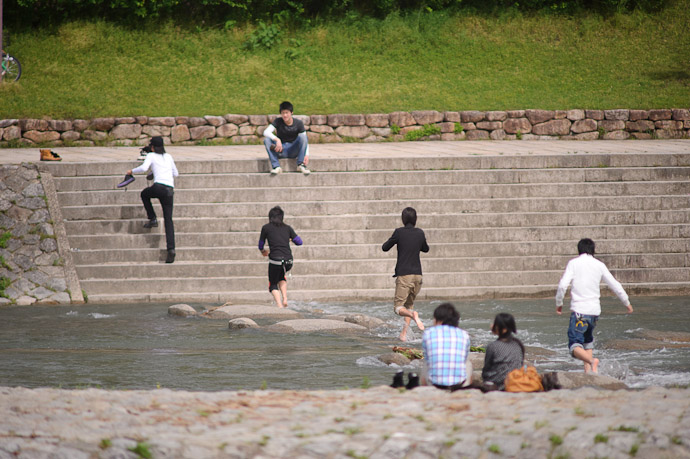
Nikon D700 + Nikkor 300mm f/2 + 1.4X TC @ 420mm — 1/4000 sec, f/2.8, ISO 900 — map & image data — nearby photos
Getting Your Feet Wet
Having finally obtained a manual for the lens I got last week, I've learned a few things. One, it seems that it actually has a built-in slide-out lens hood in addition to the big detachable hood I'd been using. You're supposed to deploy both.
Also, for some reason, it says that proper focus can't be achieved without a filter installed in the filter holder. It can be simple optically-inert glass, but you've got to have something. I don't know how it could matter, but I'll trust the maker on this. Unfortunately, the only filter holder it came with is for gelatin filters, and it was empty, so I'd been using it improperly. Nobody seems to have the normal filter holders in stock, so for the time being I got a special polarizer filter that fits, as it was both in stock and something I'd want anyway.
So, armed with this new knowledge, I went out this afternoon to the Kamo river to give it a spin, also using for the first time its dedicated 1.4× teleconverter, making a 420mm f/2.8 manual-focus lens.
I'm really disappointed with the results. I don't know whether I was just bad at hitting focus, or whether I need to spend some time calibrating the focus, but none of the photos — none — were well focused.
A bunch of hawks (which I've realized is the normal word for what I've been referring to as “kites”) were swarming across the river as a pair of ladies threw hunks of bread, so I tried shooting that. The birds could catch bread in mid air, but unfortunately, I could not do the same with the focus.
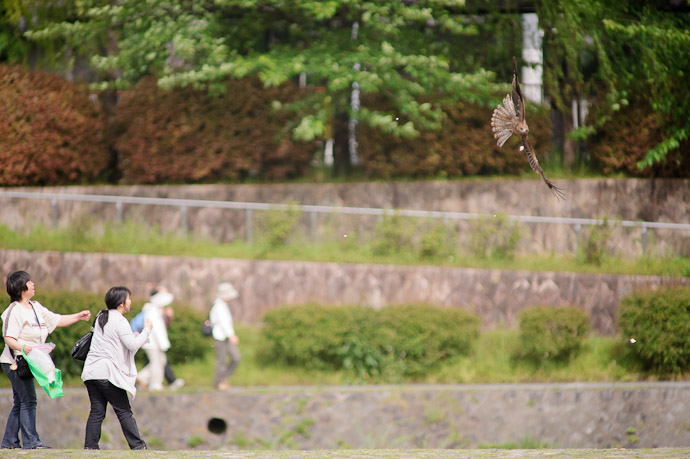
Nikon D700 + Nikkor 300mm f/2 + 1.4X TC @ 420mm — 1/4000 sec, f/2.8, ISO 1400 — map & image data — nearby photos
Drawing A Bead
the bright spot immediately below the hawk's head is a chunk of bread, soon to be lunch
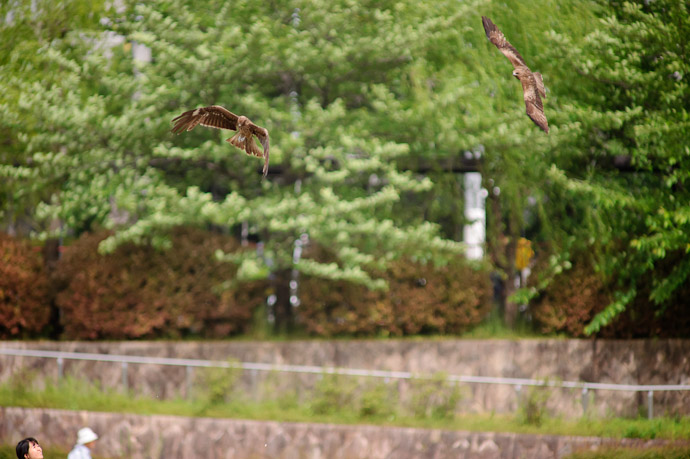
Nikon D700 + Nikkor 300mm f/2 + 1.4X TC @ 420mm — 1/4000 sec, f/2.8, ISO 2500 — map & image data — nearby photos
Sort of Pretty
but would have been better in focus
I was hoping for some shots like in “Feeding Frenzy on the Kamo River”, but these were the best I could come up with.
The water was quite high due to rain all week, though nowhere near where it was last year, but the stepping stones across the river (seen here and here) were mostly submerged...
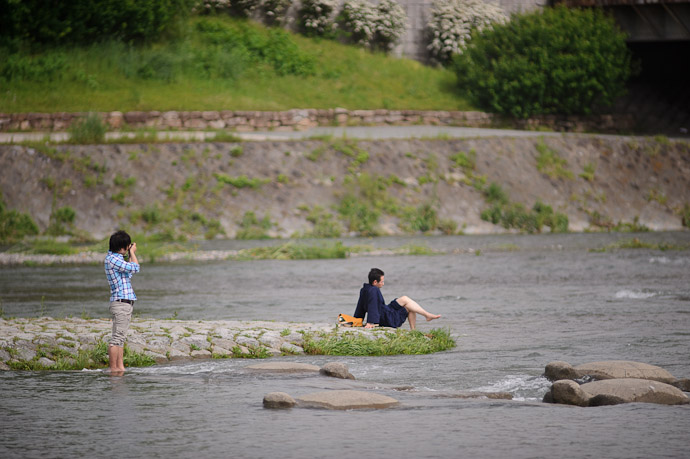
Nikon D700 + Nikkor 300mm f/2 — 1/2500 sec, f/2, ISO 280 — map & image data — nearby photos
Sort of Funny
two unrelated folks build a seemingly-related scene

Nikon D700 + Nikkor 300mm f/2 — 1/2500 sec, f/2, ISO 250 — map & image data — nearby photos
Snacking on Dried Beans
focused better than most, but lacking in the not-off-kilter department
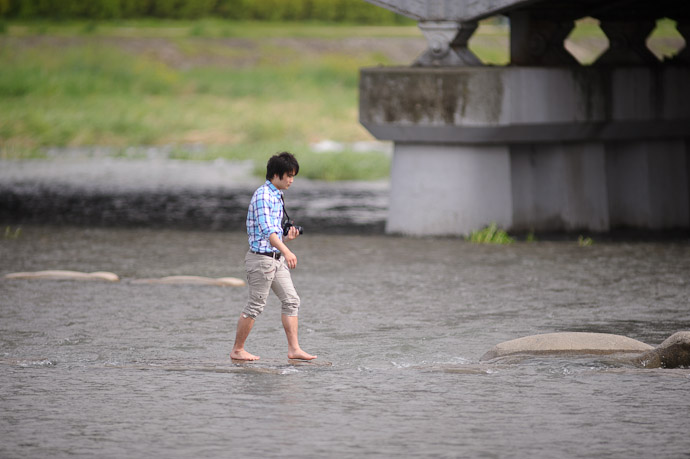
Nikon D700 + Nikkor 300mm f/2 — 1/2500 sec, f/2, ISO 360 — map & image data — nearby photos
Fisher of Photos
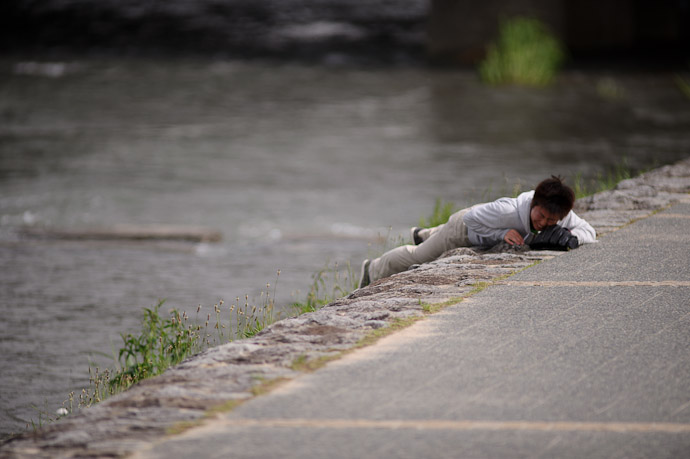
Nikon D700 + Nikkor 300mm f/2 — 1/2500 sec, f/2, ISO 220 — map & image data — nearby photos
Missed It By That Much
the white thing in the water in the lower-left is the baseball
that he dove to (try to) get before it rolled over the bank
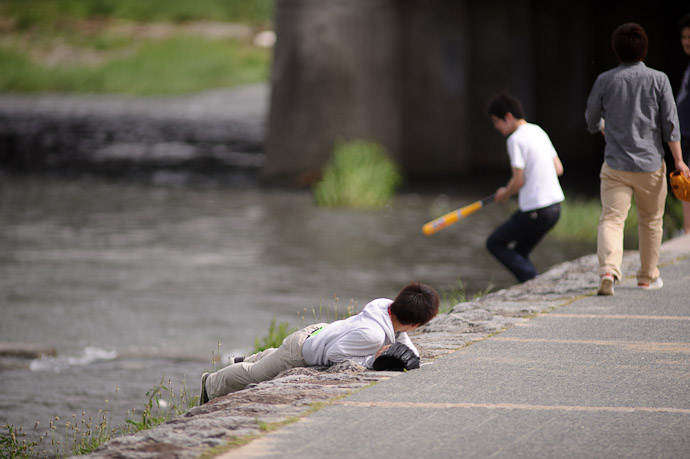
Nikon D700 + Nikkor 300mm f/2 — 1/2500 sec, f/2, ISO 280 — map & image data — nearby photos
Second Team Off the Bench

Nikon D700 + Nikkor 300mm f/2 — 1/2500 sec, f/2, ISO 320 — map & image data — nearby photos
Still Trying
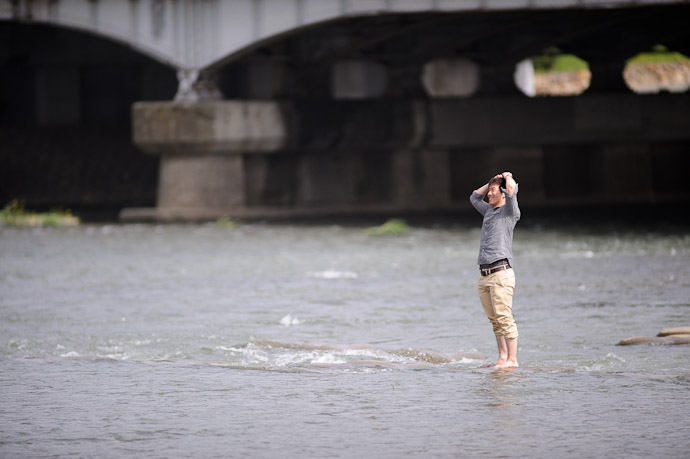
Nikon D700 + Nikkor 300mm f/2 — 1/2500 sec, f/2, ISO 360 — map & image data — nearby photos
Oh Well
there are other things we can do besides baseball
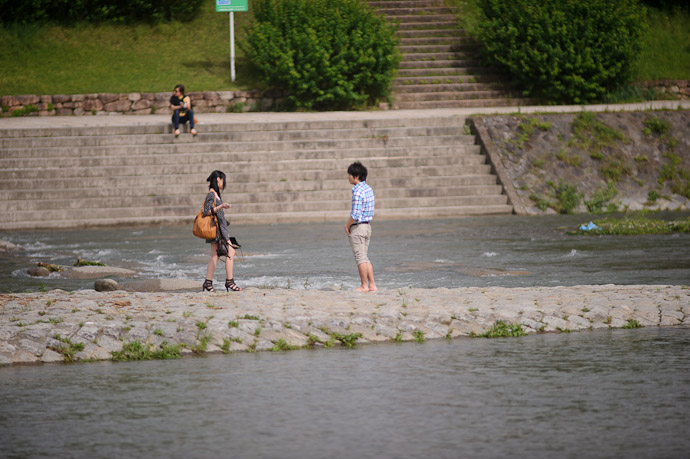
Nikon D700 + Nikkor 300mm f/2 — 1/3200 sec, f/2, ISO 200 — map & image data — nearby photos
Like a Boss
he carries himself well
while she carries his camera, his camera bag, her big bag, and his shoes
I'll need to practice.
I looked at the hawk photos at the largest they’re posted, and the focus seems fine. Maybe the plane of focus isn’t exactly where you wanted it to be, but there’s still a good amount of detail, and the sharpness seems fine. I’m sure it’s different when you’re looking at the full-resolution image at a higher magnification (and I do confess to being a pixel peeper), but they look good for web and could probably be printed well, too.
Since it’s all manual focus, I’m really impressed – particularly considering that you were working with a very shallow depth of field, and focusing from a distance.
Hi!
Just a note about the filter needed to achieve proper focus: it can make a difference at infinity focus, because the filter increases the effective optical path length very slightly. If you cannot reach infinity focus without the filter, that’s the reason: your lens is short-sighted. However, if you are focusing sufficiently close (i.e. not at the maximum focus distance), then it should make no difference.
I think you were right in the first place – these birds look like kites to me. What made you think they were hawks? I get the impression that you’re unfamiliar with using the name kite for a bird, but we have them in Europe too, and we do indeed call them kites, with hawks being different, albeit similar, birds.
The Japanese-English dictionary built in to OSX refers to the Japanese version of “kite” as “hawk” in normal usage. —Jeffrey
“Like a Boss (he carries himself well while she carries his camera, his camera bag, her big bag, and his shoes)” made me laugh for minutes! But when I read “I’ll need to practice.” you killed me! 🙂
(ok, probably you were referring to your lens, but it was so funny!)
Best from Italy
In Europe we have both red kites and black kites. In the UK only red kites, which are quite distinct – large birds (about 1.5m across the wings) with a characteristic long, reddish tail with a deep V-shaped notch – can’t mistake them for anything else. I remember seeing black kites in Japan, and thought they also had a notched tail, though less deeply so. My one book on Japanese birds confirms this, so I don’t believe these are kites (though I’m not sufficient of a birder to say what sort of hawk they may be). Can’t find it just now, but I seem to remember you do have a photograph of black kites somewhere on your blog.
Red kites were nearly extinct in Britain by the 1950s, with only a few breeding pairs surviving in mid-Wales (just where I live). In recent years, they have been reintroduced to various places in England and Scotland, I believe from Spanish rather than native Welsh stock. In the 16 years we’ve lived here, red kites have become dramatically more abundant, and we now see them far more often than we do buzzards around our house – a sight of which I never tire.
Wow for the photos, and the subject, it was very interesting to follow it.
Thanks for sharing. Anna 🙂
Japanese-English and English-Japanese dictionaries are not to be trusted, especially when it comes to animals and plants. As far as I’m concerned, Wikipedia is the best resource for these things outside of specialist books. The links between the Japanese and English versions, combined with the clear correlation between scientific names on each page, make it quite an authority. The abundance of images helps too.
I just happened on this old post by following the string of 300mm-related links from your most recent post (drowning in jealousy that there isn’t a nice 300mm prime for Sony yet), and found myself researching once again the birds I refer to as kites, which I’m pretty sure fit under some definitions of “hawk” but not others.
The thing I thought was funny in the context of a discussion of lenses is that the birds in question are of the genus milvus, a name that meant nothing to me until Zeiss released its 100mm f2 Milvus last year.